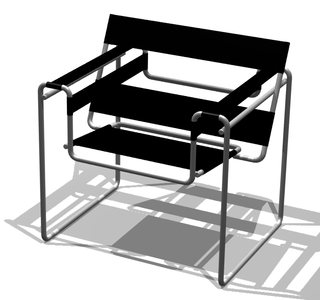
Wassily Wassilyevich Kandinsky was a Russian painter and art theorist. Kandinsky is generally credited as one of the pioneers of abstraction in western art. Born in Moscow, he spent his childhood in Odessa, where he graduated from Odessa Art School. He enrolled at the University of Moscow, studying law and economics. Successful in his profession, he was offered a professorship at the University of Dorpat. Kandinsky began painting studies at the age of 30.

The Peggy Guggenheim Collection is an art museum on the Grand Canal in the Dorsoduro sestiere of Venice, Italy. It is one of the most visited attractions in Venice. The collection is housed in the Palazzo Venier dei Leoni, an 18th-century palace, which was the home of the American heiress Peggy Guggenheim for three decades. She began displaying her private collection of modern artworks to the public seasonally in 1951. After her death in 1979, it passed to the Solomon R. Guggenheim Foundation, which opened the collection year-round from 1980.

Abstract art uses visual language of shape, form, color and line to create a composition which may exist with a degree of independence from visual references in the world.

Josef Albers was a German-born American artist and educator who is considered one of the most influential 20th-century art teachers in the United States. Born in 1888 in Bottrop, Westphalia, Germany, into a Roman Catholic family with a background in craftsmanship, Albers received practical training in diverse skills like engraving glass, plumbing, and wiring during his childhood. He later worked as a schoolteacher from 1908 to 1913 and received his first public commission in 1918 and moved to Munich in 1919.

Mordecai Ardon was an Israeli painter.
Margaret Leiteritz (1907–1976) was a German painter who studied at the Bauhaus in Dessau from 1928 to 1931.

The Wassily Chair, also known as the Model B3 chair, was designed by Marcel Breuer in 1925–1926 while he was the head of the cabinet-making workshop at the Bauhaus, in Dessau, Germany.

Hildegard Anna Augusta Elisabeth FreiinRebay von Ehrenwiesen, known as Baroness Hilla von Rebay or simply Hilla Rebay, was an abstract artist in the early 20th century and co-founder and first director of the Solomon R. Guggenheim Museum. She was a key figure in advising Solomon R. Guggenheim to collect abstract art, a collection that would later form the basis of the Solomon R. Guggenheim Museum collection. She was also influential in selecting Frank Lloyd Wright to design the current Guggenheim museum, which is now known as a modernist icon in New York City.

Solomon Robert Guggenheim was an American businessman and art collector. He is best known for establishing the Solomon R. Guggenheim Foundation and the Solomon R. Guggenheim Museum in New York City.

The Yellow Sound is an experimental theater piece originated by the Russian artist Wassily Kandinsky. Created in 1909, the work was first published in The Blue Rider Almanac in 1912.

The Deutsche Guggenheim was an art museum in Berlin, Germany, open from 1997 to 2013. It was located in the ground floor of the Deutsche Bank building on the Unter den Linden boulevard.

Moshé Raviv-Vorobeichic, known as Moi Ver, born Moses Vorobeichic (1904–1995) was an Israeli photographer and painter.
Theodore Lukas Feininger was a German-American painter, avant-garde photographer, author, and art teacher who was born in Berlin to Julia Berg, née Lilienfeld, and Lyonel Feininger, an American living in Germany from the age of sixteen. His father was appointed as the Master of the Printing Workingshop at the newly formed Bauhaus art school in Weimar by Walter Gropius in 1919. He had two older full brothers, namely Andreas Feininger, and Laurence Feininger, as well as two half sisters, even older, including Lore Feininger, by Clara Fürst and his father.
Karole P. B. Vail is an American museum director, curator and writer. Since 2017, she has been the director of the Peggy Guggenheim Collection in Venice and Solomon R. Guggenheim Foundation Director for Italy. Prior to this appointment, she worked on the curatorial staff at the Solomon R. Guggenheim Museum in New York for 20 years.

Composition X is an abstract oil painting created in 1939 by the Russian émigré artist Wassily Kandinsky, then living near Paris. It is part of the collection of the Kunstsammlung Nordrhein-Westfalen in Düsseldorf, Germany.

Landscape with Red Spots was the name given to each of two successive oil paintings produced in Bavaria in 1913 by the Russian émigré painter Wassily Kandinsky. The first is now in the Museum Folkwang, in Essen, Germany. The second, known as Landscape with Red Spots, No 2, is in the Peggy Guggenheim Collection, in Venice.
Hazel Guggenheim King-Farlow McKinley was an American painter, art collector, and art benefactor.

Auf Weiss II (Sur blanc II), in English: On White II, is an 1923 oil-on-canvas painting by Russian painter Wassily Kandinsky. It was created when the artist was a teacher at the Bauhaus in Weimar. The painting initially hung in the dining room of Wassily and Nina Kandinsky's apartment at Bauhaus Dessau. Since 1976, as a gift from Nina Kandinsky, it has been in the collection of the Musée National d'Art Moderne, in Paris.

Ein Zentrum is a painting by the Russian abstract artist Wassily Kandinsky. It was painted in 1922 or 1923, around 12 years after Kandinsky has established the Der Blaue Reiter movement. It hangs in the Kunstmuseum, in Den Haag, Netherlands.















